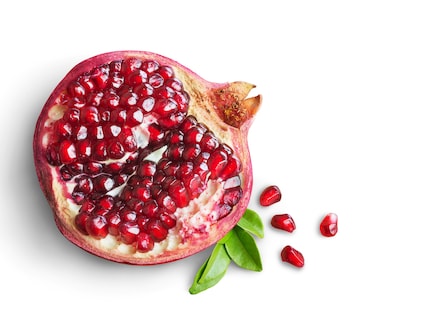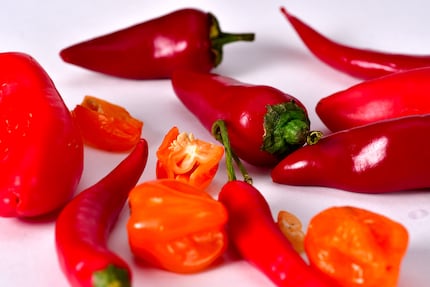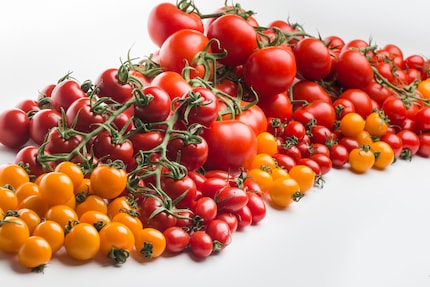
Guide
Red energy in autumn: rosehips boost your immune system, but not just that
by Anna Sandner

Red fruits and vegetables don’t just look appetising, they’re also packed with healthy nutrients. They get their colouring from anthocyanins and carotenoids – secondary plant metabolites that act as antioxidants, protecting against cancer and cardiovascular diseases.
In nature, the colour red can mean two different things. One, «This is poisonous, beware!» or two, «Hey, this fruit is ripe!» At first glance, it’s a remarkable contradiction. Whatever way you look at it, red attracts attention, be it in the positive or the negative sense.
As a striking colour, red is easily recognised by visually oriented animals (humans, for instance). Even from a distance. In the world of plants, red’s attention-grabbing properties are used in a variety of ways. On the one hand, it warns would-be plant eaters against eating poisonous specimens. On the other hand, it attracts pollinators and potential seed dispersers.
The red colouring provides another bonus in the form of UV protection, essentially acting as plant sunscreen.
Carotenoids are what give many plants and their fruit their bright red colour. Depending on the composition, they can also appear yellowish-orange – take carrots, for example. However, the colour doesn’t just make vegetables look appetising. For various reasons, carotenoids are also a real health booster.
Their most-researched benefit is their function as antioxidants. These plant substances intercept free radicals in the body, rendering them harmless and protecting against cancer and cardiovascular diseases. They also have anti-inflammatory properties, strengthen the immune system and counteract macular degeneration, an eye condition.
Anthocyanins, another group of secondary plant substances, can also give a fruit or vegetable its red colouring. Like carotenoids, they’re mostly healthy because of their antioxidant properties. Oxidative stress is associated with various diseases, including heart disease, inflammation and neurodegenerative diseases. By trapping free radicals, anthocyanins protect the body from cell damage.
As is the case with carotenoids, they also cover a whole range of colours, from red to purple to blue. Plus, they have a special effect: they change colour depending on pH levels. Under acidic conditions (low pH) they appear red, at neutral pH they’re purple and in an alkaline environment (high pH) they’re blue.
You can observe this phenomenon in ripening fruit. As the fruit’s increased sugar formation decreases pH levels, the anthocyanins change their structure and appear redder.
Neither anthocyanins nor carotenoids are a homogeneous group. In fact, both of the colourants come in an astonishing variety, boasting different structures and properties.
Some prominent members of this colour family include the anthocyanins cyanidin (red cabbage), delphinidin (saffron), malvidin (beet), pelargonidin (strawberries), peonidin and petunidin (red grapes). Carotenoids include alpha and beta carotene (carrots), lycopene (tomatoes), lutein (beans) and zeaxanthin (pumpkin).
The main thing that gives pomegranates their red colour is anthocyanins, especially the cyanidin pigment. In addition to anthocyanins, pomegranates also contain antioxidant compounds such as ellagic acid, tannins and vitamin C. Pomegranates are known for their anti-inflammatory and antioxidant properties, and can lower blood pressure, promote heart health and reduce the risk of chronic diseases.

Did you know that every single pomegranate contains more than 600 seeds? That’s plenty of prettiness for your next meal.
The red colouring of peppers and chilli peppers mainly comes from carotenoids – more specifically the carotenoid lycopene. In addition to lycopene, red peppers and chilli peppers also contain vitamin C, capsaicin (which makes chilli peppers spicy) and other carotenoids. Lycopene and vitamin C in red peppers promote skin health and strengthen the immune system. Meanwhile, capsaicin in chillies can boost your metabolism and have anti-inflammatory effects. Incidentally, red peppers contain more vitamin C than oranges. This means that just one can cover your daily vitamin C requirement.

Tomatoes’ bright red colouring mainly comes from the carotenoid lycopene. The fruit also contains vitamin C, potassium, folic acid and fibre. Not only are tomatoes pretty and well liked, they’re also bursting with nutrients.
Lycopene, a powerful antioxidant, plays a crucial role in protecting cells from free radicals and has been linked to various health benefits. These include supporting heart health, promoting eye health and reducing the risk of certain cancers, particularly prostate cancer. The combination of lycopene and vitamin C in tomatoes helps protect the skin against premature ageing and strengthen the immune system.

Hankering for something red? Let me know in the comments section which red fruits you’d like to know more about. You’ll find more about rosehips and strawberries here:
This article was published as part of our Focus Week dedicated to the colour red. Seven days, seven stories. Read more about our red-themed week and all the articles published so far here:
Header image: Christian Walker
Science editor and biologist. I love animals and am fascinated by plants, their abilities and everything you can do with them. That's why my favourite place is always the outdoors - somewhere in nature, preferably in my wild garden.
Interesting facts about products, behind-the-scenes looks at manufacturers and deep-dives on interesting people.
Show all